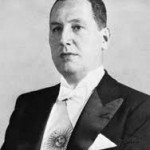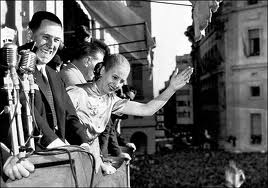Background Info
- Once installed as the President, Peron proceeded to put in the corporatist principles of the GOU (Groupo de Oficials Unidos).
- He decided that Argentina would be divided in to three functional groups; industrialist, farmers and workers. At the peak of the hierarchy would be the state.
- Peron made his urban workers his most important political ally, along eith the industrialists and the armed forces. (The alliance was a union of workers, mangers and the military).
Labour Unions
- The first signal of the shift came during a railroad workers’ strike at the end of 1943. Perón intervened and settled the strike by rewarding the key Unión Ferroviaria (Railway Union) with major concessions: Its members received a pay raise and changes in work rules in exchange for ending their walkout.

- In 1944, unions in other industries launched or threatened additional strikes. In each case, Perón arbitrated a settlement that rewarded the unions. Within months, unions recognized their opportunity. In meetings, in publications, and through public demonstrations, the unions cheered Perón and his actions.
- Peron continued the tactics he had used when he was the secretary of labour in the GUO in 1943. The real hourly wage rate jumped up nearly 25% in 1947 and 24% in 1948.
- From 1943 to 1949 labor’s share of national income rose from approximately 45 to 59 %. Most of this shift occurred from 1947 to 1949, reflecting the implementation of new social security programs as well as rising wages. Therefore, the labour workers received a sharp rise in their standard of living. However, landowners and any owners of capital were affected negatively since the government trade monopoly (IAPI), bought most of their products at low, fixed prices.
- The Instituto Argentino de Promocion del Intercambio (IAPI) the Argentine trade promotion institute was a powerful new foreign trade institute under a five-year economic plan, was given state monopoly over the export of key agricultural crops. It served as the buffer between foreign and domestic sellers and purchasers, buying domestic production for a lower figure and selling it abroad for a higher, and also intervening actively in the control and purchase of imports through licensing and otherwise. 91
- The GDP grew by 8.6% in 1946 and at the rate of 12.6% in 1947. It reduced to 5.1% in 1948, but it was competent by world standards. (Argentina)
- At the same time the pension system was expanded to all industrial workers, so that 25 percent of the workers’ wages (10 percent from the worker and the rest from the employer) was funneled into state pension funds. Pensions were set for the low age of fifty-five
- Employees gained unprecedented protections: The government set minimum wages, limited the length of the work day, restricted employers’ rights over the dismissal of employees, and mandated workplace standards in key industries. It dictated new benefits: pension plans, vacations, medical services, limitations on Sunday work hours, and housing programs.
- Trade unions, sanctioned by the government to represent workers in distinct industries and economic sectors, gained new freedoms and powersPerón ensured the unions’ loyalty by forcing out leaders who appeared to have political ambitions separate from his own. Shop, local, and national elections put in place loyalists who committed their unions to Perón and his government.
Railways
The first stages of the five year economic plan sought the nationalization of various basic enterprises. But the most important nationalization, that of the railroads, was more complicated.
The decomposing railways required capital, but did not generate it. They were not a reproductive industry, did little to stimulate economic growth, provided no new jobs except through wasteful bureaucratic staffing that became almost scandalous, and lost money by the bucket. It has been estimated (although the figures are ambiguous) that a single railroad from 1947 to 1951 lost more than half the amount spent to buy the entire network. But, in 1948 Argentina nationalized the British owned railways, which was still the main transportation system. (Peron and the enigmas of argentina)
Industrialization
As a result of economic disruptions dating back to World War I, local industries had grown in number. They employed a small but  increasing percentage of the workforce in the years following World War I. When World War II isolated Argentina from foreign markets, new industries appeared and established firms expanded in an effort to make up for the lack of imported goods. Due to the IPAI, the differential between the internal and external prices of the meat, grain, and other products that were thus traded gave the government a handsome profit, used to facilitate credit to the national industrialists.
increasing percentage of the workforce in the years following World War I. When World War II isolated Argentina from foreign markets, new industries appeared and established firms expanded in an effort to make up for the lack of imported goods. Due to the IPAI, the differential between the internal and external prices of the meat, grain, and other products that were thus traded gave the government a handsome profit, used to facilitate credit to the national industrialists.
Most industrialists objected to Perón’s actions in support of strikers during World War II. The Union Industrial Argentina (Argentine Industrial Union, or UIA), an organization of Argentine business owners, became a leading opponent of the military dictatorship in 1943. Beginning in 1945, the UIA strongly supported the Democratic Union in its efforts to block Perón’s rise to power. Seeing Perón as a demagogue, UIA representatives labeled him a mortal enemy.
In his arbitration efforts, Perón cultivated the support of many industrialists by promising to use the power of the government on their behalf. The benefits granted to workers came with important controls and restrictions that Perón characterized as advantageous for employers and employees alike. He promised government promotions of industrial expansion.
The military government, when it turned to managing the economy, tried to preserve Argentina’s “natural” industries, such as grain farming and ranching, as it developed new industries of strategic importance, such as an aircraft industry. There were also state-sponsored mixed enterprise set up to produce steel.
A new bureaucracy, the Instituto Argentino de Promoción del Intercambio (Argentine Institute for the Promotion of Trade) took charge of the country’s export industries.
Conflict
- The United States competed against Argentina for shares of the world market for agricultural goods. Unlike Argentina’s traditional trading relationship with European countries, the Argentine arrangement with the United States meant Argentina
 could not exchange its exports for U.S. imports, since tariffs and subsidies effectively blocked Argentine grain and beef from the U.S. market.
could not exchange its exports for U.S. imports, since tariffs and subsidies effectively blocked Argentine grain and beef from the U.S. market. - IAPI became the sole purchaser of rural produce. the institute had the power to set prices. By setting base prices below what its agents obtained for grains, meat, wool, and other products sold abroad. Between 1946, when IAPI began its operations, and 1956, when its last fund transfers were completed, the institute produced over 8 billion pesos
- By 1949, the Beef and meat products were the main exports from Argentina during World War II. In the years following the war’s end, domestic consumption rose since there was an increase in urban dwellings while production remained largely unchanged. Meat exports had in decades past provided some insurance: When grain production fell, the value of meat exports helped Argentina balance its foreign trade accounts. But as was the case with grains, the rising domestic demand for beef cut into meat exports.

Very helpful.